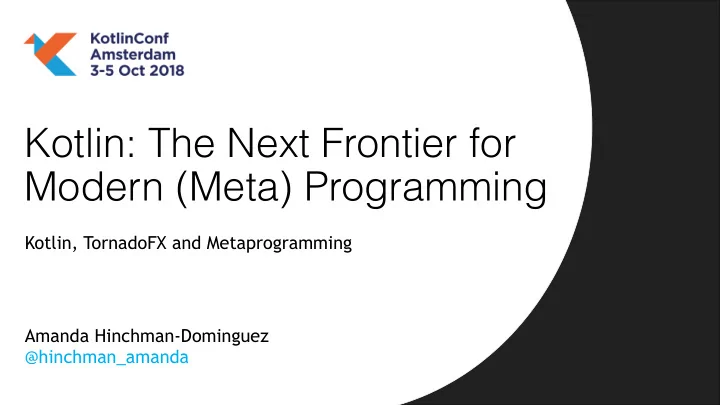

Kotlin: The Next Frontier for Modern (Meta) Programming Kotlin, TornadoFX and Metaprogramming Amanda Hinchman-Dominguez @hinchman_amanda
Thomas Nield
TornadoFX a JavaFX Framework written in Kotlin
Characteristics of Functional Languages Functions are Functions have Metaprogrammin treated as first no side-effects g capabilities class citizens
Metaprogramming is magic!! • Programs that treat programs as data – read, analyze, or transform other programs • Metaprogramming can be used to make our lives easier
Primitive Filters ( )= || or(a, b) Piq: cesarloose ( )= && remove(a, b) ! )= !( == shiftUp( ) topEdge(a)
A READABLE Horizontal Edge
A MEMORY-OPTIMAL Horizontal Edge
Crosscutting = (Scattering && Tangling) • Scattering – when a source sources element is related to multiple target elements • Tangling – when a target element is related to multiple source elements • Crosscutting occurs if there exists both scattering & tangling • “spaghetti code” targets
Metaprogramming A solution to crosscutting • We sacrifice one domain design decision for another • Metaprogramming comes in different forms • Wizards - “Monkey patching” • Aspect-Oriented Programming (AOP) • Domain Specific Languages (DSLs) Flickr: Susan Lucas Hhoffman
Aspect-Oriented Programming (AOP) • AOP is how Java approaches crosscutting • Draws out a higher level of abstraction to act as a weaver between concerns Flickr: Chris Radcliffe
Memoization - optimization technique
Java Annotations API
How does Java achieve AOP? 1. Declare the @interface 2. Specify the @Retention and its targets 3. Add elements
How does Java achieve AOP? • Dynamic introspection prime for reflection • Runtime annotation carries through to the JVM
Current Shortcomings in Aspect- Oriented Programming • Annotations are only a form of metadata • No direct effect on the annotated code • Annotation processing occurs only at designated annotations • No dynamic generation for elements • True metaprogramming doesn’t play nicely with static types • Generating code without compiling risks type-checking • True metaprogramming does not respect encapsulation • Statically-typed languages overcomplicate
Imperative v. Declarative Programming Salting your food • An imperative approach (HOW) : I see the salt is out of my reach. If I reach over the beans and the sauce and avoiding knocking the drinks over I could probably get it without brushing over my own food. • A declarative approach (WHAT) : Pass the salt please. • Execution is more efficient • Reduced bugs Flickr: Joe King
Domain-Specific Languages (DSLs) • Regular DSLs • Cares about a specific concern and nothing else • Not a general purpose language & difficult to combine with • Kotlin creates internal DSLs • Uses its own language • Retains key advantages of DSLs
Type-Safe CSS • Blocks, or { }, can be passed when the terminal parameter is a function op -> () • Type-safe builders allows Kotlin-based DSLs to create complex hierarchies in a declarative way
Higher Order Functions and Lambdas Function as a Parameter
Higher Order Functions and Lambdas Function as a Parameter Return type Receiver type Parameter types
Higher Order Functions and Lambdas Function as a Parameter A.(B) C Return type or (A, B) C Receiver type Parameter types
Reified Generics • Function bytecode copies into every place where the function is called • When the function is called the compiler modifies the generated bytecode to use the corresponding class directly • Can be used • Type checks/casts • Use the Kotlin reflection API • As a type argument to call other functions
Scopes • simple constructs used to pass objects like models to other classes • Makes the View/ Controller unique to a smaller subset of instances in an application
Passing Scopes to Components
Generic-Class-as-a-Parameter Pattern Type parameter used in receiver and return types Type parameter declaration – any Component may be passed
Passing Scopes with Reified Generics “reified” declares that this type parameter will not be erased at runtime
Passing Scopes to Components
The Takeaway • Metaprogramming is a solution to crosscutting • Common forms of metaprogramming has their shortcomings • TornadoFX leverages functional Kotlin features to streamline JavaFX
TORNADO FX SUITE
Challenges w/ Statically-Typed Metaprogramming • True reflection does not respect encapsulation • Generating code at runtime means no compiler for type-checking
Special Thanks • Carl Walker #TornadoFX channel on Slack @bekwaminc • Kotlin community • KotlinConf Committee Edvin Syse @edvinsyse • Ebad Ahmadzadeh Thomas Neild @thomasneild9727 Ruckus T Boom @ruckustboom
Recommend
More recommend